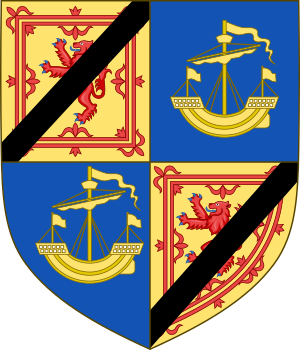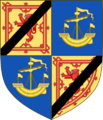Patrick Stewart, 2nd Earl of Orkney facts for kids
Patrick Stewart, Earl of Orkney, Lord of Zetland (born around 1566 – died February 6, 1615) was a Scottish nobleman. He was the son of Robert, Earl of Orkney, who was a son of King James V. Patrick was known for his strict rule over the Scottish islands of Orkney and Shetland. He was later put on trial and executed in 1615.
Patrick's Early Life and Career
Patrick was the second of five sons born to Earl Robert and his wife, Lady Jean Kennedy. When his uncle, Lord Robert, passed away in 1581, Patrick received the Priory of Whithorn. After his older brother Henry died around 1588, Patrick became the next in line to inherit the Earldom of Orkney.
As a young man, Patrick spent some time with his brother-in-law, Patrick Vans of Barnbarroch, in Ayrshire. In 1582, his father wrote to Barnbarroch, thinking about sending young Patrick to Geneva for his education. The Earl asked Barnbarroch to send Patrick to Kirkwall by the next available boat.
In his youth, Patrick was good friends with his cousin, James VI, who later became King. However, their friendship became difficult in the 1590s after Patrick became the Earl of Orkney. In 1589, Patrick wrote from Kirkwall about a pirate named Peterson. This pirate claimed to have a letter from Earl Robert to the Duke of Parma. Such a letter could cause problems for them, and Patrick hoped Barnbarroch could help.
Patrick was accused of taking goods from a ship from Danzig in 1594, but he was found innocent. In the same year, he accused three of his younger brothers of planning to harm him. This happened after he found one of his brother John's servants with a harmful substance. The servant was put on trial, and a woman named Allison Balfour was also accused of helping in the plot. The brothers, however, were later found innocent.
Patrick became an important person at the King's Court. He served as an assistant to the King at the baptism of his son, Prince Henry Frederick, in 1594. He ruled Orkney and Shetland in the north of Scotland almost like an independent ruler. He was very strict with the islanders and got into a lot of debt.
In 1599, he built Scalloway Castle on the Mainland of Shetland. He did this partly to make his power stronger against his half-uncle, Laurence Bruce, who had been made Sheriff of Shetland by Patrick's father. Patrick also had disagreements with George Sinclair, the Earl of nearby Caithness. In March 1599, King James VI told Patrick and George to prepare their castles in case of an attack by the exiled Earl of Bothwell. This concern came up again in July 1601. In 1607, Earl Patrick started building the Earl's Palace in Kirkwall, which was the main town of Orkney.
In March 1600, Patrick joined the King on a hunting trip in Teviotdale in the Scottish borders.
Earl Patrick's money problems and his harsh treatment of the local people led to him being called before the Privy Council in 1609. He was then put in prison, first in Edinburgh Castle and later in Dumbarton Castle.
Rebellion and Execution
After Earl Patrick was imprisoned, he sent his son, Robert Stewart, to start a rebellion in Orkney to support him. In May 1614, Robert took over the Palace of Birsay with about thirty friends. Then, he occupied the Earl's Palace, the castle, and St Magnus' Cathedral in Kirkwall. Around 700 rebels joined him, saying they were bringing back royal justice to Orkney while the Earl was away.
Robert was defeated by a force led by the Earl of Caithness at the end of September, after a five-week siege of the Earl's Palace. The Earl of Caithness attacked the Palace with many cannon shots. He said the castle was so strong that some of his cannonballs broke in half. Twelve of Robert's men were executed at the castle gate.
Robert was taken to Edinburgh, put on trial, and executed along with five other people. Robert and his father said they had not planned the rebellion together. However, Robert's helper, Patrick Halcro, said he had followed Earl Patrick's instructions. A servant named Margaret Buchanan said she had read instructions for Halcro written by the Earl. She said Halcro showed the paper to Robert, who tore it up. They both told her it was better that way, so it could not cause trouble later. Robert was around twenty-two years old and was described as tall and handsome. Many people felt sorry for him when he was executed.
Earl Patrick's trial happened after his son's. He lost his titles and was sentenced to death. His execution was delayed because the chaplains found him to be very uneducated. They wanted time to teach him and give him Communion. The execution finally took place on February 6, 1615. He was taken to the Mercat Cross in Edinburgh and executed.
Family Life
In 1595, King James suggested that Earl Patrick marry Emilia, a sister of Count Maurice of Nassau. An envoy, Colonel Stewart, proposed this idea to strengthen the friendship between Scotland and the Netherlands. However, there were concerns about Patrick's right to Orkney and Shetland. Also, Emilia did not want to live so far from her home and family.
Instead, Patrick married Margaret Livingstone on August 19, 1596. Margaret was a wealthy widow and a daughter of the Lord Livingston. She was also a lady-in-waiting in the households of Anne of Denmark and Prince Henry. Patrick spent all her money and left her to live in poverty. They did not have any children together.
Patrick did have several children outside of marriage:
- Robert Stewart, whose mother was Marjorie Sinclair. Marjorie was with her son during the siege of Kirkwall and was wounded.
- Mary Stewart
- Catherine Stewart, who married John Sinclair of Ulbster.
Images for kids





